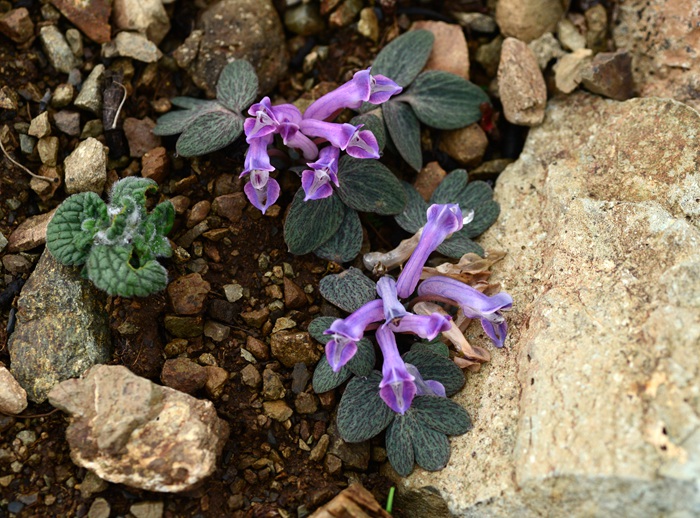- Scientific Name: Corydalis benecincta W.W.Sm.
- Ref: Notes Roy. Bot. Gard. Edinburgh 9:98. 1916
- Chinese Common Name: 囊距紫堇 nángjù zǐjǐn
- Family: Papaveraceae
- Genus: Corydalis
- Distribution: Alpine scree, on “shale” and on limestone; 4000-6000 m. ?SW Sichuan, SE Xizang, NW Yunnan (Dêqên to Weixi)
- Photo: Baima Snow Mt., Yunnan
Tuber elongate, with yellow flesh, 3-6 cm, ± branched. Stems 15-30 cm, with 2-4 scales, with 3 or 4 leaves, branched; lower 1/2 of plant buried beneath surface. Leaves trifoliolate, long petiolate; leaflets glaucous on both surfaces, often mottled with irregular streaks, obovate, 2-2.5 × 1.5-2 cm, base often cuneate. Inflorescence without a distinct stalk, loosely corymbose, 5-15-flowered, often branched at base; bracts obovate-oblong to oblanceolate, (1-)2-3(-4.5) cm × 3-8 mm, acute, entire, lower one sometimes slightly lobate. Fruiting pedicel arcuately downcurved, elongating to 25-70 mm, soft and slightly thickened. Flowers pale pink to pale amaranth, with pinkish veins, often with bluish tints, broad in profile, strongly fragrant. Sepals nearly orbicular, ca. 2 mm, circumdentate. Upper petal 18-25 mm with narrow crest, apically with rather broad margins flanking inner petals; spur downcurved, large, 10-13 mm, very broad and saccate; nectary ca. 1/2 as long as spur; lower petal with reflexed apex; inner petals 9-10 mm. Stigma nearly square, broader than long, with 4 apical papillae and lateral and basal geminate papillae. Capsule elliptic, 7-10 × 4-5 mm, 5-15-seeded; style ca. 4 mm, usually sharply bent at base in fruit. Seeds 2-2.5 mm, faintly colliculate, with very broad elaiosome. Self-incompatible. Fl. and fr. Jul-Sep. 2n = 16*. (Flora of China)
